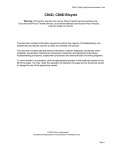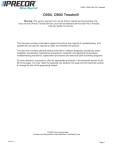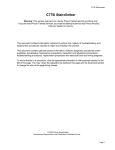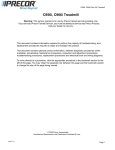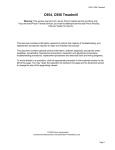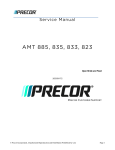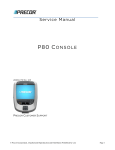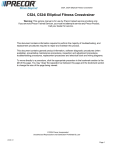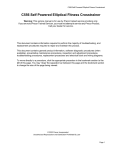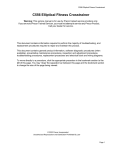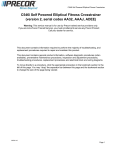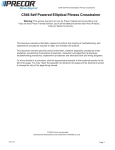Download Service Manual, UBK 815 Bicycle.fm
Transcript
UBK 815 Upright Cycle UBK 815 Bicycle Warning: This service manual is for use by Precor trained service providers only. If you are not a Precor Trained Servicer, you must not attempt to service any Precor Product; Call your dealer for service. This document contains information required to perform the majority of troubleshooting, and replacement procedures required to repair and maintain this product. This document contains general product information, software diagnostic procedures (when available), preventative maintenance procedures, inspection and adjustment procedures, troubleshooting procedures, replacement procedures and electrical block and wiring diagrams. To move directly to a procedure, click the appropriate procedure in the bookmark section to the left of this page. You may “drag” the separator bar between this page and the bookmark section to change the size of the page being viewed. Page 1 UBK 815 Upright Cycle © 2010 Precor Incorporated Unauthorized Reproduction and Distribution Prohibited By Law Page 2 UBK 815 Upright Cycle Section One - Things You Should Know Right, Left, Front, and Back Conventions In this manual, right, left, front, and back are from the perspective of a user sitting on the UBK 815 facing the display enclosure. Warning and Caution Statements and General Safety Guidelines Warning statements indicate a particularly dangerous activity. Warning statements you will find in this manual include: • • • To remove power from the UBK 815 the optional power adapter must be disconnected from the cycle. Always ensure that the optional power adapter is disconnected from the cycle when you inspect or adjust the UBK 815 or when you isolate, remove, or replace a component. Removing the covers exposes high voltage components and potentially dangerous moving parts. Exercise extreme caution when you perform maintenance procedures with the hood removed. During service operations you will be very close to moving machinery and high voltage components. When you perform maintenance procedures with the covers removed, remove jewelry (especially from ears and neck), tie up long hair, remove neck ties, and do not wear loose clothing. • Exercise caution when touching any wire or electrical component during operation. • Caution statements are intended to prevent damage to the bicycle as a result of the current activity. Caution statements included in this manual are listed below: Safety guidelines you should know and follow include: • Read the owner’s manual and follow all operating instructions. • Visually check the bicycle before beginning service or maintenance operations. If it is not completely assembled or is damaged in any way, exercise extreme caution while operating and checking the bicycle. • When operating the bicycle, do not wear loose clothing. Do not wear shoes with heels or leather soles. Check the soles of your shoes and remove any embedded stones. Tie long hair back. • Do not rock the unit. Do not stand or climb on the handlebars, display enclosure, or cover. • Do not set anything on the handlebars, display enclosure, or cover. While servicing, Page 3 UBK 815 Upright Cycle never place liquids on any part of the bicycle The water bottle holder must be empty. • To prevent electrical shock, keep all electrical components, such as the power cord and power adapters away from water and other liquids. • Do not use accessory attachments that are not recommended by the manufacturer, such attachments might cause injuries or damage to the unit. General Information For the latest exploded view diagram, part number and part pricing information, visit the Precor dealer website at “www.precor.com/connection”. Page 4 UBK 815 Upright Cycle Required Tools and Equipment The following is a summary of the tools and equipment that may be required when you service a Precor UBK 815 Upright Cycle. Tools Phillip and flat-head screwdrivers Standard and metric allen wrench set Open-end wrench set 1-1/8 inch thin open end wrench Socket wrench set Rubber mallet Snap ring pliers Torque wrench 20030-119 secondary sheave tool Park Tool CCP-22 crankarm puller or equivalent (available at bicycle shops) Kent Moore BT-33-73Fdrive belt tension gauge or equivalent Equipment Anti-static kit Digital multimeter Supplies Cable ties Page 5 UBK 815 Upright Cycle Section Two - Preventive Maintenance Preventive maintenance measures are either scheduled or unscheduled. Scheduled preventive maintenance activities are included here so that you are aware of preventive measures performed on a regular basis. Regular Preventive Maintenance (Owner) Cleanliness of the cycle and its operating environment will keep maintenance problems and service calls to a minimum. Precor recommends that you perform the following preventive maintenance schedule. After Each Use • Turn off and, unplug the power adapter (if equipped) from the bicycle. • Wipe down the covers, handlebars, seat and pedals with a damp cloth. Daily Maintenance Clean the bicycle’s frame, covers, seat and pedals using a water damped cloth. Wipe the surface of the electronic console with a damp sponge or soft cloth. Dry with a clean towel. Weekly Maintenance • Clean underneath the bicycle, following these steps: 1.Turn off the bicycle with the on/off switch, then unplug it from the power adapter (if equipped). 2.Place the bicycle on its side. Note: Place a drop cloth under the bicycle to protect the flooring and to ensure that the cycle handrail is not scratched or damaged. 3.Vacuum the rug or damp mop the floor. 4.Make sure that the floor is dry before returning the bicycle to an upright position. Page 6 UBK 815 Upright Cycle Quarterly Maintenance 1. Remove the cover. 2. Thoroughly clean inside the bicycle. Use a vacuum cleaner and damp rag to remove all the dust belt particles, etc. 3. Check the belt tension of both belts per Procedures 5.1 and 5.2. 4. Replace both covers. On-Site Preventive Maintenance (Service Technician) When you are called to service a UBK 815 perform these preventive maintenance activities: • Perform the software diagnostics. Check LED and keypad function. Record the odometer reading. See Procedure 3.1. • Visually inspect the drive belts for cracks, fraying or excessive wear. • Visually examine all wires and check connectors and wire connections. Secure connections and replace wiring as necessary. Page 7 UBK 815 Upright Cycle Procedure 3.1 - Accessing the Diagnostic Software The treadmill's diagnostic software consists of the following modes: • • • • Display Test Keyboard Test Heart Rate Test Machine Test Procedure 1. Using the RESET key and the numeric keypad, press keys RESET,5,1,7,6,5,7,6,1, sequentially. 2. Hardware Validation will scroll across the display followed by DISPLAY TEST. Diagram 3.1 - UBK 815 Display OK Key Numeric Keypad Clear key Reset Key Page 8 UBK 815 Upright Cycle 3. Press the OK key, the upper most group of LED’s will illuminate on the display. Check the display to ensure that all LED segments are illuminated. 4. Press the OK key four more times to display the remaining LED groups. Check each display group to ensure that all LED segments are illuminated. 5. Press the CLEAR key then the q key, KEYBOARD TEST will scroll across the display. 6. Press the OK key, a representation of all of the keys on the console will be displayed. Pressing a key on the console will cause the representation of that key to go off. Press all of the keys on the console to ensure that all of the keys are functioning. 7. Press and hold the CLEAR key then the q key, HEART RATE will be displayed. 8. Grasp both of the heart rate grips on the handlebar, after a couple of seconds the heart rate will be displayed in the heart rate and smart rate displays. 9. Use chest strap transmitter or a test transmitter to test the wireless heart rate function, after a couple of seconds the heart rate will be displayed in the heart rate and smart rate displays. 10. Press the CLEAR key then the q key, MACHINE TEST will scroll across the display. 11. Press the OK key, BRAKE test will be displayed. 12. Press the q key, PWRB will be displayed with the current power bit setting. 13. Press the CLEAR key, BRAKE test will be displayed. 14. Press the q key, RPM will be displayed with the current pedaling speed. 15. Press the q key, BATTERY test will be displayed. 16. Press the OK key, the battery voltage will be displayed as XX.X VDC. 17. Press the RESET key to exit the hardware validation test. Page 9 UBK 815 Upright Cycle Procedure 3.2 - Information Display Software version numbers are invaluable for tracking and identifying problems and staying aware of changes to the operation and features of the product. Procedure The information display will access the following data; • • • • • • • • Odometer Hour Meter U-Boot Software U-Base Software Lower Software Serial Number Usage log Error Log Procedure 1. Plug the power cord into the wall outlet, then turn on the treadmill with the circuit breaker. 2. With the PRECOR banner scrolling, press the keys RESET,6,5, sequentially. 3. DIAGS-INFORMATION DISPLAY will scroll across the display. 4. Use the p,q keys to move to the desired display shown in the list above. 5. ODOMETER display. Press the OK key. 6. The odometer will be displayed as XXX miles. Note: The odometer data is stored in non-volatile memory on the upper PCA. If the upper PCA is replaced the odometer data will be lost. 7. Press the CLEAR key to exit the odometer display. 8. HOUR METER display. Press the OK key. 9. The operating time of the unit will be displayed as 12345 HOURS. The operating time is defined as total amount of time that the unit has operated in program modes with the drive motor running. The hour meter is also used to provide the “time stamp” for the error code log. 10. Press the CLEAR key to exit the hour meter display. Page 10 UBK 815 Upright Cycle 11. U-BOOT SW display. This display the installed version of upper boot software. The boot software is used to upload new software into the upper display PCA. 12. Press the OK key. The software part number will be displayed as XXXXX-XXX. 13. Press the CLEAR key to exit the U-Boot SW display. 14. U-BASE SW display. This display the installed version of upper PCA software. 15. Press the OK key. The software part number will be displayed as XXXXX-XXX. 16. Press the CLEAR key to exit the U-Base SW display. 17. LOWER SW display. This display the installed version of lower PCA software. 18. Press the OK key. The software part number will be displayed as XXXXX-XXX. 19. Press the CLEAR key to exit the lower SW display. 20. SER. NUMBER display. Press the OK key. 21. The bicycle’s serial number will be displayed. The serial number may be incorrect or not displayed if the upper PCA has been replaced. 22. Press the CLEAR key to exit the serial number display. 23. USAGE LOG display. Press the OK key. 24. Use the p,q keys to move through the list of programs. A message will scroll describing the program, the number of times and the number of minutes the program was used. 25. Press the CLEAR key to exit the usage log display. 26. ERROR LOG display. Press the OK key, the quantity of errors in the log will be displayed. 27. Press the OK key, the most recent error will be displayed first. 28. Use the p,q keys to move through the list of errors. The error messages will list the error name and the odometer reading when the error occurred. 29. If you wish to clear the error log, press and hold the QUICK START key. The message HOLD TO CLEAR ERRORS will be displayed. The error log will be cleared when the message NO ERRORS is displayed. 30. Press the RESET key to exit the information display. 31. Please note that the ERROR LOG may also be accessed at any time by pressing and holding the RESET key for four seconds. If the error log does not contain any errors, the message STUCK KEY will be displayed. Page 11 UBK 815 Upright Cycle Procedure 3.3 - Selecting Club Settings Procedure This procedure allows you to change the following club settings: • • • • • • Select Language Select Units Set Max Workout Time Set Max Pause Time Set Cool Down Time Set Resistance Range Procedure 1. Pedal the bicycle or install the optional external power supply. 2. With the banner scrolling, press keys RESET,5,6,5,1,5,6,5, sequentially. 3. Use the p,q keys to move to the desired display shown in the list above. 4. DIAGS-SET CLUB PARAMETERS will scroll across the display. 5. When SELECT LANGUAGE is displayed. Press the OK key. 6. Use the p,q keys to toggle between the available languages. 7. Press the CLEAR key to exit the select language display. 8. SELECT UNITS display. Press the OK key. 9. Use the p,q keys to toggle between U.S and METRIC measurements. 10. Press the CLEAR key to exit the set units display. 11. SET MAX WORKOUT TIME display. Press the OK key. 12. Use the p,q keys to select the maximum time a user can remain in a program. 13. Press the CLEAR key to exit the set max. workout time display. 14. SET MAX PAUSE TIME display. Press the OK key. 15. Use the p,q keys to select the maximum time a program will remain in the pause mode. 16. Press the CLEAR key to exit the set max. pause time display. 17. SET COOL DOWN TIME display. Press the OK key. 18. Use the p,q keys to select the cool down time. Page 12 UBK 815 Upright Cycle 19. Press the CLEAR key to exit the set cool down time display. 20. SET RESISTANCE RANGE display. Press the OK key. 21. Use the p,q keys to select to HIGH, MEDIUM or LOW resistance range. 22. Press the CLEAR key to exit the set resistance range display. 23. Press the RESET key to exit the Club Settings Program Page 13 UBK 815 Upright Cycle Procedure 3.4 - Documenting Software Problems When a problem is found with either the software or upper or lower PCA’s, record the information listed below. If you isolated the problem to either the PROM, upper PCA, or lower PCA, include the information you recorded with the malfunctioning PROM or PCA when you ship it to Precor. When a problem occurs, record the following information: • Model and serial number • Software version number Note: A label on the PCA indicates the software version number. • User and program number running when the problem occurred • A description of: a What happened or failed to happen. b The action taken by the user just before the problem occurred. c Problem-related information (such as how far into the program the problem occurred, the work level being used when the problem occurred, etc.). d The frequency of occurrence. Page 14 UBK 815 Upright Cycle Section Four - Checking Operation This section provides you with a quick method of checking operation. Procedure 1. Start pedaling. 2. With the banner displayed, press QUICK START. 3. Select Resistance Level 1 and press ENTER. 4. Operate the UBK 815 for 4–5 minutes. As you operate the bike, concentrate on the operating sounds made by the unit. Be on the alert for unusual rubbing, hitting, grinding, or squeaking noises. 5. If the electronic display does not change appropriately, troubleshoot per Procedure 6.3. 6. Press the RESISTANCE s key until you reach Resistance Level 10. Operate the C846 for another 2–3 minutes. 7. If the resistance does not change or the operation of the bike feels inconsistent compared with Resistance Level 1, troubleshoot per section 6. 8. Press the RESISTANCE s key until you reach Resistance Level 20. Operate the bike for another 2–3 minutes. 9. If the resistance of the bike does not change or operation feels inconsistent with Resistance Levels 1 and 20, troubleshoot per Procedure 6.2. 10. Check the LED’s mounted on the upper PCA and the function keys displayed on the electronic console by performing Procedure 3.1. Page 15 UBK 815 Upright Cycle Procedure 5.1 - Primary Belt Tension Adjustment 1. Remove the covers per Procedure 7.1. 2. Place the belt tension gauge on the primary belt. The belt will twist when the tension gauge is engaged. The belt tensions have been adjusted to accommodate the twisting of the belt. See Diagram 5.1. Diagram 5.1 - Primary Belt Tensioning 3. The correct belt tension is 90 pounds ± 5 pounds. If the belt tension range is correct, skip to step 7. 4. If the belt tension is incorrect, slightly loosen the idler pulley mounting nut. The idler pulley mounting bolt also fastens the belt adjustment bracket. The belt tension can not be adjusted if the idler pulley mounting bolt is tightened. See Diagram 5.2. Page 16 UBK 815 Upright Cycle Diagram 5.2 - Primary Belt Adjustment Adjustment Bolt Adjustment Bracket Idler Pulley Mounting Bolt Page 17 UBK 815 Upright Cycle 5. Turn the adjustment bolt clockwise or counter clockwise, as required, until the belt gauge is in the range of 90 pounds ± 5 pounds. Torque the idler pulley adjustment bolt to 120 inch poinds (10 foot pounds). 6. You may find, depending on how much the idler pulley mounting bolt was loosened, that the belt tension increases when the idler pulley mounting bolt is tightened. If so, slightly loosen the idler pulley mounting bolt. Then return to step 5 and set the belt tension on the low side, so that the belt tension is correct when the idler pulley mounting bolt is torqued to 120 inch pounds. 7. Replace the covers per Procedure 7.1. Page 18 UBK 815 Upright Cycle Procedure 5.2 - Secondary Belt Tension Adjustment 1. Remove the covers per Procedure 7.1. 2. Place the belt tension gauge on the secondary belt. The belt will twist when the tension gauge is engaged. The belt tensions have been adjusted to accommodate the twisting of the belt. See Diagram 5.3. Diagram 5.3 - Secondary Belt Tensioning 3. The belt tension should be in the range of 75 pounds ± 5 pounds. If the belt tension is correct, skip to step 6. 4. If the belt tension is incorrect, loosen the 4 bolts that secure generator to the frame, then turn the adjustment bolt clockwise or counterclockwise, as required, until the belt tension is in the range of 75 pounds ± 5 pounds. See Diagram 5.4. 5. Re-Torque the generator bolts to 100 ± 10 inch pounds. Page 19 UBK 815 Upright Cycle Diagram 5.4 - Secondary Belt Adjustment Adjustment Bolt 6. Replace the covers per Procedure 7.1. Page 20 UBK 815 Upright Cycle Procedure 6.1 - Display does not Illuminate Note: In order to conserve battery power when the cycle is not in use, a time out feature is incorporated in the cycles software. If the cycle is not used (motion not detected by the speed sensor), when in the program mode, approximately 15 seconds later, the cycle will “power down” The bike will “power up” again when pedaling is resumed (motion detected by the speed sensor). In order to measure voltages in the unit it is necessary to keep the unit powered up. This can be accomplished either by pedaling on the unit or by installing the optional external power adapter. 1. Attach the anti-static wrist strap to your arm, then connect the ground wire of the wrist strap to the units frame. 2. Pedal on the cycle for a minimum of 5 seconds. The system monitors one of the three phase generator windings for AC zero cross. The monitoring system notes every time the generator AC voltage passes through zero volts. By counting the zero cross rate, the system knows how fast the generator is turning. The system calculates the user RPM from the generator speed. If the system does not see a zero cross rate, it assumes the bike is not being used and the display will not illuminate when the bike is pedaled. 3. Disconnect the generator leads from terminals M3 (red) and M4 (black) on the lower PCA. Connect and AC voltmeter to the leads removed from terminals M3 and M4. Pedal the bike at about 60 RPM (1 rotation per second), the voltmeter should read approximately 120 Vac. If the voltage reading is absent or extremely low, replace the generator. 4. If the voltage reading in step 2 was normal, replace the lower PCA. If the lower PCA did not correct the problem, continue with step 4. 5. With the unit powered up, measure between test point 19 and test point 20 for approximately 8.5 Vdc. See Diagram 6.1. If the measurement is correct, skip to step 7. Page 21 UBK 815 Upright Cycle Diagram 6.1 - Lower PCA, UBK 815 M1, M2 M3, M4, M5 TP19 TP20 J2 M6, M7 J4 Page 22 UBK 815 Upright Cycle 6. If the measurement in step 2 is significantly low or high, disconnect the interconnect cable from the J2 connector and repeat the measurement in step 4. 7. If the measurement in step 2 is still significantly low or high, replace the lower PCA. If replacing the lower PCA does correct the problem, skip to step 9. 8. Remove the upper display panel and disconnect the interconnect cable from the upper PCA. With the unit powered up, check the voltage between the outer two pins of the interconnect cable for DC volts. It should read approximately 8.5 Vdc. If the voltage is absent or significantly low, troubleshoot the interconnect cable. 9. If the voltage measurement in step 4 is correct, replace the upper PCA. 10. If you have performed all of the previous tests and have not been able to locate the trouble, call Precor customer support. Page 23 UBK 815 Upright Cycle Procedure 6.2 - No or Incorrect Pedaling Resistance 1. If the display is not illuminated, go to Procedure 6.3. 2. Enter the “manual” program and set the work level at “level 20”. Pedal the cycle and confirm that there is no resistance or that the resistance is abnormally low. Note: The voltage readings in this procedure will vary with the pedaling rate. Pedal the cycle at approximately 60 RPM with the work level set at “10” while taking the voltage readings in this procedure. Resistance readings must be taken with the power off and the cycle idle. 3. Measure the DC voltage at the terminals M1 and M2 of the lower PCA. See Diagram 6.1. The voltage reading should be approximately 11 Vdc. If the reading is significantly low, or significantly high, skip to step 5. 4. If the reading in step 3 was correct, the pedalling resistance should be correct, skip back to step 2. 5. Disconnect the eddy current magnet wires from terminals M1 and M2 of the lower PCA. Measure between the eddy current magnet wires with an ohmmeter. It should read approximately 10 W. Diagram 6.2 - Eddy Current Magnet, UBK 815 Generator Eddy Current Magnet 6. If the measurement in step 5 was significantly high or low, replace the generator. The eddy current magnet is furnished with the generator. After replacing the generator, tension the secondary belt per Procedure 5.2. 7. If the measurement in step 5 was correct, replace the lower PCA. 8. It is highly unlikely that the RPM reading could be present but incorrect. If this condition should occur, replace the lower PCA Page 24 UBK 815 Upright Cycle Procedure 6.3 - Troubleshooting the Keypad and Upper PCA If the function keys on the electronic console are unresponsive, the problem may be either the upper PCA or keypad. WARNING Before continuing with this procedure, review the Warning and Caution statements listed in Section One. 1. Attach the anti-static wrist strap to your arm, then connect the ground wire of the wrist strap to the units frame. 2. If the bicycle powers up and functions normally until a particular key(s) is pressed, skip to step 10. 3. If a “stuck key” message is immediately displayed when the bicycle is powered up, continue with the next step. 4. This condition may be caused by either the keypad or upper PCA. 5. Remove the four screws that attach the display’s rear cover. 6. Unsnap display front panel from the display back panel. Remove the keypad cable from the upper PCA. Refer to Diagram 6.3. Page 25 UBK 815 Upright Cycle Diagram 6.3 - Upper PCA & Keypad Upper PCA Keypad Cable D-Pad Cable Metrics Cable Metrics PCA D-Pad Assembly D-Pad Clip Page 26 UBK 815 Upright Cycle 7. If a “stuck key” message is immediately displayed when the bicycle is powered up, replace the upper PCA. 8. If a “stuck key” message is not displayed when the bicycle is powered up, replace the display front panel. The display front panel is equipped with the keypad. 9. If you have performed all of the procedures above and have been unable to correct the problem, call Precor customer service. 10. Access the diagnostics program per procedure 3.1 If the key(s) necessary to access the diagnostic program is not functioning, skip to step 14. 11. Test the keypad per Procedure 3.1. 12. If all of the keys test good, the problem may be user error or a key function that is normally disabled during a particular user program. 13. If one or more keys do not function correctly, either the keypad (display front panel) or upper PCA could be defective. Replace the display and repeat step 11. If the display front panel did not correct the problem, re-install the original display front panel and replace the upper PCA. 14. If you have performed all of the procedures above and have been unable to correct the problem, call Precor customer service. Page 27 UBK 815 Upright Cycle Procedure 6.6 - Troubleshooting Hand Held Heart Rate Circuit Description The hand held heart rate system is actually a dual system, that is, it can accept a heart rate signal from either the hand held heart rate contacts on the unit’s handlebar or from a Polar heart rate chest strap transmitter. The PCA is configured for hand held priority. That is, if both a chest strap and hand heart rate signal are being received, the system will accept the hand held signal and ignore the chest strap signal. If a hand held signal is not being received, the system will accept the chest strap signal. Note: There are four typical failure modes for the hand held/chest strap heart rate system. They are: hand held is normal - no chest strap reading; no hand held reading - chest strap normal; no hand held or chest strap reading or constant or intermittent readings when neither hand held or chest strap are in use. Diagram 6.4 - Heart Rate Printed Circuit Board HR Contact Plate Lower Left Ground Upper Left Upper Right Lower Right Vdc HR out Normal hand held reading - No chest strap reading 1.Access the diagnostic program (Procedure 3.1). Advance to the heart rate display portion of the diagnostic program. Verify that a chest strap signal is not being accepted with either a Polar heart rate test transmitter or a known good chest strap transmitter. If this reading is good, skip to step 3. 2.Using a known good Polar heart rate chest strap, verify that the heart rate operates with the known good chest strap. If the known good Polar chest strap does correct the problem, replace the original chest strap transmitter. 3.If the above procedures did not correct the problem, replace the heart rate PCA. Page 28 UBK 815 Upright Cycle No hand held reading - Normal chest strap reading 4.Access the diagnostic program (Procedure 3.1). Advance to the heart rate display portion of the diagnostic program. Verify that a hand held signal is not being accepted by firmly grasping both the right and left hand held contacts on the handlebars. Cover as much of the contact surface area with your hands as possible (without moving your hands), you should receive a heart rate reading within ten seconds. 5.If the hand held signal is now being accepted, something in the near vicinity is radiating RF (radio frequency) energy that is being received by the chest strap portion of the heart rate PCA. 6. If a hand held signal still not being accepted, skip to step 8. 7.Constant or intermittent heart rate readings when neither heart rate system is in use is caused by something in the near vicinity radiating RF energy that is being received by the chest strap portion of the heart rate PCA. Locate the device that is causing the RF interference. Possible solutions are to relocate the bicycle, relocate the device causing the RF interference or turn off the device causing the RF interference while the bicycle is in use. 8.Access the diagnostic program (Procedure 3.1). Advance to the heart rate display portion of the diagnostic program. Verify that a hand held signal is not being accepted by firmly grasping both the right and left hand held contacts with the opposite hands, right hand on the left handlebar contacts and left hand on the right handlebar contacts. Cover as much of the contact surface area with your hands as possible, you should receive a heart rate reading within ten seconds. If a hand held signal is still not being accepted, skip to step 10. 9.If a hand held signal was accepted in step 8, the hand held contact wiring is reversed. The end of the wire harness that connects to the hand held contacts in the handlebar is segregated into two groups. One group has blue shrink wrap around it and the other group has black shrink wrap around it. The “blue” group must go to the right hand contacts and the “black” group must go to the left hand contacts. In both groups the black wire must go to the lower contact and the red wire must go to the upper contact. If necessary, rewire the hand held contacts as described above and test as described in step 4. 10.If the wiring is correct, refer to Diagram 6.3 for the following measurements. With an ohmmeter measure between the “lower right contact” pin of the 4 pin connector and the lower right hand held heart rate contact on the handlebar. The reading should be 1 W or less. Measure between the “upper right contact” pin of the 4 pin connector and the upper right hand held heart rate contact on the handlebar. The reading should be 1 W or less. Measure between the “upper left contact” pin of the 4 pin connector and the upper left hand held heart rate contact on the handlebar. The reading should be 1 W or less. Measure between the “lower left contact” pin of the 4 pin connector and the lower left hand held heart rate contact on the handlebar. The reading should be 1 W or less. If any of the above readings are greater than 1 W, Page 29 UBK 815 Upright Cycle replace the heart rate PCA to handlebar wire harness. Page 30 UBK 815 Upright Cycle No hand held reading - No chest strap reading 11.Access the diagnostic program (Procedure 3.1). Advance to the heart rate display portion of the diagnostic program. Verify that neither a chest strap signal or a hand held signal is being accepted with either a heart rate test transmitter or a chest strap transmitter. 12.Check the plug/connector connections on both the heart rate PCA (3 pin connector), and upper PCA (J4). 13.If neither a chest strap signal or a hand held signal is being accepted, measure between the “ground” and “5 Vdc” pins on the 3 pin connector for 5 Vdc. If 5 Vdc is present, replace the heart rate PCA. 14.If 5 Vdc is not present, remove the connector from 3 pin connector of the heart rate PCA. Measure between the “ground” and “5 Vdc” pins of the connector (just removed from the heart rate PCA) for 5 Vdc. If 5 Vdc is present, replace the heart rate PCA. If the 5 Vdc is not present, measure between the corresponding pins of J4 on the upper PCA (red and black wires). If 5 Vdc is not present replace the upper PCA. If 5 Vdc is present, replace the upper PCA to heart rate PCA cable. Constant or intermittent readings when neither the hand held or chest strap is in use 15.Constant or intermittent heart rate readings when neither heart rate system is in use is caused by something in the near vicinity radiating RF energy that is being received by the chest strap portion of the heart rate PCA. Locate the device that is causing the RF interference. Possible solutions are to relocate the bicycle, relocate the device causing the RF interference or turn off the device causing the RF interference while the bicycle is in use. Page 31 UBK 815 Upright Cycle Procedure 7.1 - Replacing a Cover Cover Removal 1. Remove the two screws from the rear of the top rear cover. Remove the top rear cover. Slide the cover gasket a short distance up the seat post. See Diagram 7.1. Diagram 7.1 - Top Rear Cover Cover Gasket Top Rear Cover 2. Remove two screws (one each side) from the front portion of the top main cover. Remove the top main cover. See Diagram 7.2. Diagram 7.2 - Top Main Cover Top Main Cover Left Side Cover 3. Remove six screws from the left side cover. Remove the left side cover. Remove five screws from the right side cover. Remove the right side cover. See Diagram 7.2. Page 32 UBK 815 Upright Cycle Cover Replacement 4. Set the right side cover in its mounting position. Fasten with the five screws removed in step 3 above. Torque the cover screws to 20 inch pounds. 5. Slide the assembly containing the CAT5 and coax connectors into the slot in the lower front portion of the right side cover. See Diagram 7.3. Note: The battery fits in a pocket in the right and left side covers. Ensure that the battery is fully within the pockets and that the wire harness is routed to the left side. The battery’s long axis is from front to rear. If the battery is not correctly oriented the side cover pockets it won’t fit correctly and the crankarms may rub the side covers when the bike is used. Diagram 7.3 - CAT5, Coax Connector Assembly 6. Set the left side cover in its mounting position with the CAT5, coax connector assembly in the slot in the lower front portion of the left side cover and the battery in the cover’s battery pocket. Fasten the left side cover with the six screws removed in step 3 above. Torque the cover screws to 20 inch pounds. 7. Set the top main cover in its mounting position. Fasten it with the two screws removed in step 2 above. Torque the cover screws to 20 inch pounds. 8. Slide the cover gasket down into place in the top cover. Set the top rear cover in its mounting position. Fasten it with the two screws removed in step 1 above. Torque the cover screws to 20 inch pounds. Page 33 UBK 815 Upright Cycle Procedure 7.2 - Replacing a Primary Belt 1. Remove all of the covers per procedure 7.1. 2. Loosen but do not remove the idler pulley mounting nut. 3. Loosen the primary belt tension adjustment bolt to remove tension from the primary belt. See Diagram 7.4. 4. Remove and discard the primary belt. Diagram 7.4 - Primary Belt Primary Belt Tension Adj. Bolt Idler Pulley Input Pulley Secondary Sheave Idler Pulley Mounting Nut Primary Belt 5. Place the replacement primary belt in its mounting position around the input pulley, under the idler pulley and around the secondary sheave. 6. Tension the primary belt per Procedure 5.1. When the belt tension is correct, torque the idler pulley mounting nut to 120 inch pounds (10 foot pounds). 7. Replace the covers per procedure 7.1. Page 34 UBK 815 Upright Cycle Procedure 7.3 - Replacing a Secondary Belt 1. Remove all of the covers per Procedure 7.1. 2. Remove tension from the secondary belt by loosening the secondary belt adjustment bolt mounted on the generator. See Diagram 7.5. Diagram 7.5 - Secondary Belt Secondary Pulley Generator Secondary Belt Secondary Belt Adj. Bolt Generator Mounting Bolt Generator Pulley Generator Mounting Bolt 3. Loosen but do not remove the four generator mounting bolts. 4. Lift the generator, it will pivot on the rear mounting bolts, to remove the generator’s weight from the secondary belt then remove and discard the secondary belt. 5. Lift the generator and place the replacement secondary belt in its mounting position around the generator and secondary pulleys. 6. Tension the secondary belt per Procedure 5.2. 7. Torque the four generator mounting bolts to 100 inch pounds. Recheck the belt tension, if it is no longer correct, slightly loosen the four generator mounting bolts and return to step 6. 8. Replace the covers per Procedure 7.1. Page 35 UBK 815 Upright Cycle Procedure 7.4 - Replacing a Crankarm 1. Using an open end wrench, remove the pedal from the crankarm being replaced. 2. A Park Tool CCP-22 crankarm puller will be used to remove the crankarms. Diagram 7.6 - Park Tool CCP-22 Crankarm Puller 3. Using an allen wrench, remove the crankarm mounting bolt. 4. Remove the nut from the crankarm puller. Thread the nut fully into the crankarm, until the bottoms out. See Diagram 7.7. Note: If the nut is not fully threaded into the crankarms, the crankarm’s threads may be destroyed when the crankarm is removed. 5. Thread the crankarm puller into the nut removed from the crankarm puller. See Diagram 7.7. When the crankarm puller tightens in the crankarm, continue rotating the crankarm tool clockwise until the crankarm is removed. Diagram 7.7 - Crankarm with Crankarm Puller Step 4 Step 3 6. The right hand crankarm has a pin on the rear that fits into the input pulley. The left hand crankarm does not have a pin on the rear. 7. Set the replacement crankarm in its mounting position, ensuring that the pin (right hand crankarm only) on the crankarm is inserted in its mating hole in the input pulley. 8. Thread the crankarm mounting bolt, removed in step 2 into the crankarm until it Page 36 UBK 815 Upright Cycle is finger tight. Torque the crankarm bolt to 360 inch pounds (30 foot pounds). 9. The right hand pedal threads onto the crankarm in a normal (clockwise) direction, the left hand crankarm is reverse (counter-clockwise) threaded. 10. Install the pedal, removed in step 1, on the replacement crankarm and torque it to 800 inch pounds (67 foot pounds). Page 37 UBK 815 Upright Cycle Procedure 7.5 - Replacing the Input Pulley 1. Remove the covers per Procedure 7.1. 2. Remove the right crankarm per Procedure 7.4. 3. Loosen, but do not remove the idler pulley mounting nut. 4. Remove tension from the primary belt by turning the primary belt tension adjustment bolt counter-clockwise. See Diagram 7.4. 5. Remove the primary belt. 6. Remove the retaining nut from the center of the input pulley while holding the opposite end of the input axle with an open end wrench. See Diagram 7.8. Diagram 7.8 - Input Pulley Input Pulley Retaining Nut 7. Remove the input pulley and discard. 8. Slide the replacement input pulley onto the input axle, ensuring that the spacer is still in place behind the input pulley. 9. Thread the retaining nut, removed in step 6. onto to the input axle, finger tight only at this time. 10. Place the primary belt in its mounting position around the input pulley, under the idler pulley and around the secondary sheave. 11. Replace the right crankarm per procedure 7.4, steps 6 to 8. 12. Using the thin 1-1/8 inch end wrench, reach behind the crankarm and securely tighten (counter-clockwise) the input pulley’s retaining nut. 13. Tension the primary belt per procedure 5.1. 14. Replace the covers per Procedure 7.1. Page 38 UBK 815 Upright Cycle Procedure 7.6 - Replacing the Input Axle Assembly 1. Remove the covers per Procedure 7.1. 2. Remove both crankarms per Procedure 7.4. 3. Loosen, but do not remove the idler pulley mounting nut. 4. Remove tension from the primary belt by turning the primary belt tension adjustment bolt counter-clockwise. See Diagram 7.4. 5. Remove the primary belt. 6. Remove the retaining nut from the center of the input pulley. 7. Slide the input pulley off of the input axle assembly and remove spacer. 8. Remove the two small screws and washers that retain the input axle assembly. See Diagram 7.9. Diagram 7.9 - Input Axle Assembly Axle Retaining Screw 9. Slide the input axle assembly out of the frame and discard. 10. Slide the replacement input axle assembly into its mounting position in the frame. 11. Slid spacer onto axle assembly. 12. Fasten the input axle assembly with the screws and washers remove in step 8. 13. Slide the input pulley, removed in step 7, onto the input axle assembly. Thread the nut, removed in step 6, onto the input axle assembly. Finger tight only at this time. 14. Place the primary belt in its mounting position around the input pulley, under the idler pulley and around the secondary sheave. 15. Replace the right crankarm per procedure 7.4, steps 6 to 8. 16. Using the thin 1-1/8 inch end wrench, reach behind the crankarm and securely Page 39 UBK 815 Upright Cycle tighten (counter-clockwise) the input pulley’s retaining nut. 17. Tension the primary belt per Procedure 5.1. 18. Replace the left crankarm per procedure 7.4. 19. Replace the covers per Procedure 7.1. Page 40 UBK 815 Upright Cycle Procedure 7.7 - Replacing the Idler Pulley 1. Remove both covers per Procedure 7.1. 2. Loosen, but do not remove the idler pulley mounting nut. 3. Remove tension from the primary belt by turning the primary belt tension adjustment bolt counter-clockwise. See Diagram 7.4. 4. Remove the primary belt. 5. Remove the idler pulley by removing the idler pulley mounting nut. Discard the idler pulley. 6. Mount the replacement idler pulley using the nut removed in step 5. The idler pulley mounting nut should only be finger tight at this time. 7. Replace the primary belt and tension the primary belt per Procedure 5.1. 8. Torque the idler pulley mounting nut to 120 inch pounds (10 foot pounds). 9. Replace the covers per Procedure 7.1. Page 41 UBK 815 Upright Cycle Procedure 7.8 - Replacing the Secondary Sheave 1. Remove both covers per Procedure 7.1. 2. Loosen, but do not remove the idler pulley mounting nut. 3. Remove tension from the primary belt by turning the primary belt tension adjustment bolt counter-clockwise. See Diagram 7.4. 4. Remove the primary belt. 5. Insert a 1/4 inch allen wrench into the primary pulley, the allen wrench will keep the secondary axle from turning and allow the secondary sheave to be removed. 6. While holding the secondary axle with a 3/8 inch allen wrench, use the 20030-119 sheave removal tool and a 1/2 inch drive socket wrench to remove the secondary sheave. See Diagram 7.10. Diagram 7.10 - Secondary Sheave Removal 20030-119 Sheave Tool 7. Thread the replacement sheave onto the secondary axle assembly. Using the allen wrench, 20030-119 sheave tool and socket wrench securely tighten the secondary sheave. 8. Replace the primary belt and tension the primary belt per Procedure 5.1. 9. Torque the idler pulley mounting nut to 120 inch pounds (10 foot pounds). 10. Replace the covers per Procedure 7.1. Page 42 UBK 815 Upright Cycle Procedure 7.9 - Replacing the Secondary Pulley 1. Remove all of the covers per Procedure 7.1. 2. Loosen, but do not remove the generator screws and tension bracket mounting bolt, thread the tension adjustment bolt counter-clockwise to remove tension from the secondary belt. See Diagram 7.13. 3. Remove the retaining clip from the secondary axle. See Diagram 7.11. Diagram 7.11 - Secondary Pulley Secondary Pulley Retaining Clip Plastic Washer 4. Remove the plastic washer and the secondary pulley. Discard the secondary pulley. 5. Slide the replacement secondary pulley onto the secondary axle. Slide the plastic washer, removed in step 4 onto the secondary axle. fasten the secondary pulley with the retaining clip removed in step 4. 6. Replace the secondary belt and tension it per Procedure 5.2. 7. Replace the covers per procedure 7.1. Page 43 UBK 815 Upright Cycle Procedure 7.10 - Replacing the Secondary Axle Assembly 1. Remove all of the covers per Procedure 7.1. 2. Loosen, but do not remove the idler pulley mounting nut. 3. Remove tension from the primary belt by turning the primary belt tension adjustment bolt counter-clockwise. See Diagram 7.4. 4. Loosen, but do not remove the generator and tension bracket mounting bolt, thread the tension adjustment bolt counter-clockwise to remove tension from the secondary belt. See Diagram 7.13. 5. Remove the secondary sheave per Procedure 7.8. 6. Remove the secondary pulley per Procedure 7.9. 7. Remove a second plastic washer from the secondary pulley side of the secondary axle. 8. Remove a retaining clip from the secondary pulley side of the secondary axle. 9. Remove a large retaining clip from the secondary sheave side of the secondary axle. 10. Remove the secondary axle from the frame and discard. 11. Slide the replacement secondary axle into its mounting position in the frame. Fasten the secondary axle with the large retaining clip removed in step 9. Inspect the retaining clip to insure that it is securely snapped in. 12. Replace the retaining clip removed in step 8. 13. Slide a plastic washer, removed in step 7, onto the secondary pulley side of the secondary axle. 14. Replace the secondary pulley per Procedure 7.9. 15. Replace the secondary sheave per procedure 7.8. 16. Tension the secondary belt per Procedure 5.2. 17. Tension the primary belt per Procedure 5.1. 18. Replace the covers per Procedure 7.1. Page 44 UBK 815 Upright Cycle Procedure 7.11 - Replacing a Generator 1. Remove the covers per Procedure 7.1. 2. Disconnect the two generator cables from the lower PCA. The cables are connected to M1, M2 and M3, M4, M5 on the lower PCA. See Diagram 6.1. Remove the generator clips from their cable retaining clips. See Diagram 7.13. 3. Remove the tension adjustment bolt and washer, remove the tension bracket mounting bolt, washer and tension bracket. See Diagram 7.13. 4. Loosen the three generator mounting bolts, one front and two rear. 5. Lift the generator, it will pivot on the rear mounting bolts, to remove the generator’s weight from the secondary belt then remove the secondary belt. Diagram 7.13 - Generator Tension Adjustment Hardware Tension Adjustment Bolt & Washer Tension Bracket Bolt Tension Bracket Cable Retaining Clip 6. Remove three generator mounting bolts, one front and two rear. 7. Remove and discard the generator. 8. Set the replacement generator in its mounting position. Hand start and hand tighten the three generator mounting bolts removed in step 6. 9. Place the tension adjustment bolt and washer in its mounting position on the replacement generator. 10. Thread the adjustment bolt into the tension bracket. Fasten the tension bracket with the bolt and washer removed in step 3. The bolt should only be hand tight. 11. Replace the secondary belt. 12. Tension the secondary belt per Procedure 5.2. 13. Torque the three generator mounting bolts and the tension bracket bolt to 100 Page 45 UBK 815 Upright Cycle inch pounds. 14. Reconnect the two generator cables, removed in step 2 to the lower PCA. Connect the two red magnet wires to terminals M1 & M2, the order does not matter. Connect the red generator wire to M3, the white generator wire to M4 and the black generator wire to M5. See Diagram 7.14. 15. Replace the covers per Procedure 7.1. Page 46 UBK 815 Upright Cycle Procedure 7.12 - Replacing a Battery 1. Remove the top rear, top main and left side covers per Procedure 7.1. 2. The battery is held in place by the covers. 3. Remove the red and black wires from the battery. 4. Remove the battery and properly dispose of the battery. 5. Set the battery on the frame near its mounting position with the positive terminal (red dot) to the front. 6. If the battery does not have a wire clip on the left side, positive side of the battery, add one at this time. 7. Connect the black wire to the battery’s negative terminal and the red wire to the battery’s positive (red dot) terminal. 8. Route the cables to left side and run them through the wire clip. Ensure cable is not run near the primary pulley. 9. Slide the battery in into the battery pocket in the right hand cover, the battery must be oriented with its long axis side and the wire harness must be run to left side of the bike. If the battery orientation is incorrect, the covers will not fit. 10. Replace the covers per Procedure 7.1. Page 47 UBK 815 Upright Cycle Procedure 7.13 - Replacing the Lower PCA 1. Remove the covers per Procedure 7.1. 2. Disconnect all of the wires from the lower PCA. 3. Remove the four screws that fasten the lower PCA. Remove and discard the lower PCA. 4. Set the replacement lower PCA in its mounting position and fasten it with the four screws removed in step 3. 5. Reconnect the wiring to the lower PCA as follows: two red generator magnet wires to M1, M2; red generator wire to M3, white generator wire to M4, black generator wire to M5; red battery wire to M6, Black battery wire to M7; the data cable to connector J2. See Diagram 7.14. Diagram 7.14 - Lower PCA Black Battery Wire Red Battery Wire Data Cable Generator Magnet Wires 6. Red, White Black Generator Wires Replace the covers per Procedure 7.1. Page 48 UBK 815 Upright Cycle Procedure 7.14 - Seat Post Removal 1. Remove the top rear and top main covers per Procedure 7.1. 2. The bicycle uses a universal seat. Loosen but do not remove the seat’s mounting nut. Remove the seat. 3. Remove the bolt that retains the seat post stop. Remove the seat post stop. See Diagram 7.15. Diagram 7.15 - Seat Post Stop Seat Post Stop Retaining Bolt 4. Lift the orange seat post height adjustment handle, lift seat post until you see the window in the post. Press on the seat post collar tabs located on the left and right side of seat post frame. Lift and remove the seat post from the bicycle. 5. Slide the replacement seat post into the bicycle frame until the window can be seen at the top of the frame and then snap the collar in place 6. Move the seat post down until the post locks into the frame. 7. Replace the seat stop and fasten it with the bolt removed in step 3. Torque the bolt to 50 inch pounds. Page 49 UBK 815 Upright Cycle Procedure 7.15 - Replacing a Display Front Panel, Upper PCA, Metrics PCA or HR PCA The keyboard is part of the display front panel front panel. If the keyboard is not functioning properly, replace the display front panel front panel. Removing the Display Front Panel 1. Remove the top rear, top main and right side covers and disconnect the red battery wire from the battery. WARNING Before continuing with this procedure, review the Warning and Caution statements listed in Section One, Things You Should Know. 2. Attach the anti-static wrist strap to your arm, then connect the ground wire of the wrist strap to the units frame. 3. Remove the four screws that secure the display’s rear cover. 4. Disconnect the interconnect cable and heart rate cable from the upper PCA. Diagram 7.16 - Display, with Rear Cover Removed Snap Interconnect Cable Snap Heart Rate Cable Snap HR PCA 5. Starting from the top and working downward, unsnap the display front panel from the display. There are six snaps retaining the display front panel. See Diagram 7.16. 6. Proceed to the upper PCA, metrics PCA, HR PCA, D-Pad or display front panel Page 50 UBK 815 Upright Cycle replacement procedure as required. Removing and Replacing the Upper PCA 7. Carefully disconnect the keyboard cable from the upper PCA. See Diagram 6.3. 8. Disconnect the cables from the metrics PCA and the and the D-pad PCA. See Diagram 6.3. 9. Unsnap the upper PCA from the display front panel. Note: Package the upper PCA in an anti-static bag and document the problem as described in Procedure 3.4, Documenting Software Problems. 10. Position the upper PCA at its mounting location on the display front panel and snap it into place (refer to Diagram 6.3). 11. Reconnect the keyboard cable, D-pad cable and metrics PCA cable to the upper PCA. See Diagram 6.3. 12. Skip to step 33. Replacing a Metrics PCA 13. Disconnect the metrics cable from the metrics PCA. See Diagram 6.3. 14. Unsnap the metrics PCA from the display front panel and discard. 15. Place the replacement metrics PCA in its mounting position on the display front panel and snap it into place. 16. Reconnect the metrics cable to the metrics PCA. Caution: Ensure that the cable is oriented correctly with the red wire at pin 1 of the connector. All 8’s will be displayed if the cable is reversed. 17. Skip to step 33. Replacing a HR PCA 18. Disconnect the HR PCA to UPCA cable and HR PCA to hand grips cable from the HR PCA. See Diagram 7.16. 19. Unsnap the HR PCA from the display front panel and discard. 20. Place the replacement HR PCA in its mounting position on the rear of the display front panel and snap it into place. 21. Reconnect the HR PCA to UPCA cable and HR PCA to hand grips cable to the HR PCA. Page 51 UBK 815 Upright Cycle 22. Skip to step 33. Replacing a D-Pad Assembly 23. Disconnect the D-pad cable from the D-pad assembly. See Diagram 6.3. 24. Unsnap the D-pad assembly from the display front panel and discard. 25. Place the replacement D-pad assembly in its mounting position on the display front panel and snap it into place. 26. Reconnect the D-pad cable to the D-pad assembly 27. Skip to step 33. Replacing a Display Front Panel 28. Remove the keypad cable from the upper PCA. Remove the metrics cable from the upper PCA and metrics PCA. Remove the D-pad cable from the upper PCA and D-pad assembly. See Diagram 6.3. 29. Remove the upper PCA, metrics PCA, and D-pad assembly from the display front panel as described in the above procedures. 30. Snap the upper PCA, metrics PCA and D-pad assembly onto the replacement display front panel. 31. Reconnect the keypad cable to the upper PCA. Reconnect the metrics cable to the upper PCA and metrics PCA. Reconnect the D-pad cable to the upper PCA and the D-pad assembly. 32. Starting from the bottom and working upward, snap the display front panel onto the display back panel. 33. Reconnect the interconnect and heart rate cables to the upper PCA. 34. Remove the ground wire of the wrist strap from the bicycle frame, then remove the wrist strap from your arm. 35. Position the display’s rear cover on the display back panel. Replace and tighten the display mounting screws. 36. Replace the red battery wire removed in step 1. 37. Replace the covers per Procedure 7.1. 38. Check unit operation as described in Section Four. Page 52 UBK 815 Upright Cycle Procedure 7.16 - Replacing a Seat Post Component 1. Remove the seat post stop from the seat post. See Diagram 7.15. 2. Remove the seat post assembly from the bike. Per Procedure 7.4 3. Remove the seat from the seat post assembly. Disassembly 4. From the top of the seat post assembly, remove the two screws that fasten the seat handle to the seat post. 5. Spread the seat handle and remove it from the seat post assembly. Remove the pin from the link rod. See Diagram 7.17. Diagram 7.17 - Seat Handle Link Rod Seat Handle Mounting Screw Seat Handle Pin 6. From the bottom of the seat post assembly, remove the two screws that fasten the seat post slider to the seat post assembly. Remove the seat post slider and link rod. The link rod is attached to the seat post slider assembly with a clevis pin and retaining clip.See Diagram 7.18. 7. If the collar is being replaced, slide the collar off of the seat post. 8. If the link rod or its fastening hardware is being replaced, remove the remaining clip from the clevis pin. remove the clevis pin and separate the link rod from the seat post slider. Page 53 UBK 815 Upright Cycle Diagram 7.18 - Seat Post Slider Seat Post Set Post Slider Set Post Slider Mounting Screw Collar Retaining Clip Clevis Pin Link Rod Reassembly 9. Slide the collar onto the seat post so that it is angled downward toward the front of the seat post. See Diagram 7.19. Diagram 7.19 - Collar Collar Seat Post, Front 10. Fasten the link rod to the seat post slider with the clevis pin and retaining clip removed in step 6. 11. Slide the link rod/seat post slider assembly into the bottom of the seat post so that the seat post slider is fully into the seat post and the link rod is visible at the top of the seat post. 12. Fasten the seat post slider to the seat post with the screws removed in step 6. 13. Place the pin in the link rod at the top of the seat post. See Diagram 7.20. Page 54 UBK 815 Upright Cycle Diagram 7.20 - Link Rod and Pin Pin Seat Post Link Rod 14. Spread the seat handle and fit the handle onto the pin, while it is mounted in the link rod. the pin must be in its pocket in the seat handle. See Diagram 7.21. 15. An assistant will be required during this step. Have your assistant press the pin in the seat post slider in, causing the link rod to extend farther out of the top of the seat post. Rotate the seat handle past the bosses (that the seat handle retaining screws thread into) so the bosses fit into their pockets in the seat handle. See Diagram 7.21. Diagram 7.21 - Seat Handle Installation Boss Pockets Pin Pockets Pin in Pin Pockets Boss 16. Fasten the seat handle with the screws that were removed in step 4. 17. When the handle is correctly assembled, the pin will be square in it’s pockets and the handle will be fastened to the bosses on the seat post. See Diagram 7.22. Page 55 UBK 815 Upright Cycle Diagram 7.22 - Seat Post Handle Retaining Screw Pin Link Rod Page 56 UBK 815 Upright Cycle Wiring Diagram 8.1 - UBK 815 J1 J9A J4 J7 HHHR Grips J2 J4 HHHR Grips Optional A.C. Adapter M3 M5 M4 M1 M2 M6 M7 Page 57 UBK 815 Upright Cycle Block Diagram 8.2 - UBK 815 Page 58


























































